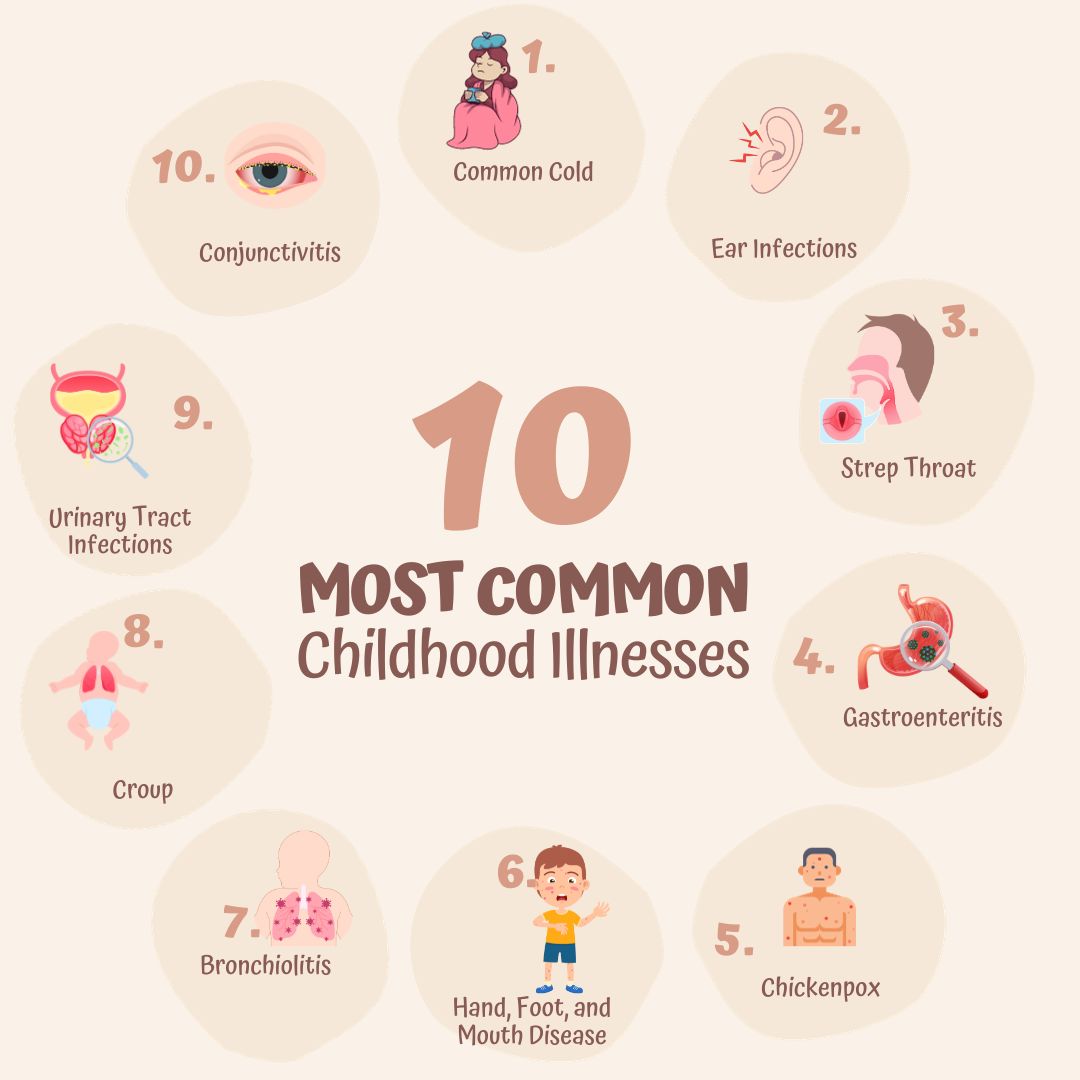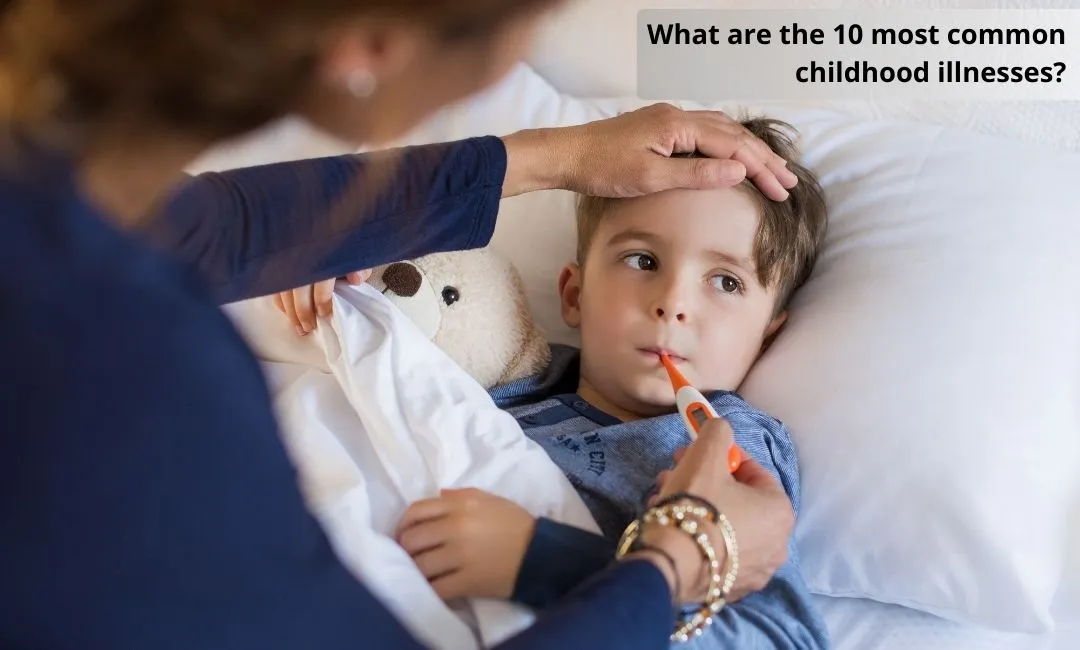Children's Day is a celebration of the joy, innocence, and boundless potential embodied by the little ones in our lives. As we revel in the spirit of this special day, it's essential to address a crucial aspect of childhood – health. Children are susceptible to various illnesses, and understanding the most common ones is pivotal for parents and caregivers. In this blog , we will delve into the 10 most prevalent childhood illnesses, equipping you with the knowledge to ensure the well-being of the little stars in your life.

If you suspect that your child may have any of these 10 common illnesses, it is essential to seek medical attention promptly. Consult with General Physician or Pediatrician to ensure your child's health.
10 Most Common Childhood Illnesses
Common Cold:
The common cold is one of the most prevalent childhood illnesses, caused primarily by rhinoviruses. Symptoms include a runny or stuffy nose, sneezing, coughing, and sometimes a low-grade fever. The virus spreads through respiratory droplets, making it highly contagious. While the common cold is usually a mild and self-limiting illness, it can be challenging for young children who may experience discomfort and disrupted sleep. Treatment involves rest, hydration, and over-the-counter medications to alleviate symptoms, but antibiotics are ineffective since the common cold is viral in nature.
🥗 Healthy Plate Challenge
🍽 Add Your Favorite Dish
Pick Your 6 favorite foods, eat, and see the results.Drag & drop foods onto your plate.
Drop Food Here
Ear Infections:
Otitis media is a common childhood ailment characterized by inflammation of the middle ear. It often follows a cold or respiratory infection when bacteria or viruses migrate to the ear. Children are more prone to ear infections due to their smaller and more horizontal Eustachian tubes. Symptoms include ear pain, difficulty hearing, and sometimes fever. Treatment may involve antibiotics for bacterial infections, pain relief, and in some cases, the insertion of ear tubes to facilitate drainage. Persistent or recurrent ear infections may require medical evaluation to address underlying issues.
Strep Throat:
Streptococcal throat infection, commonly known as strep throat, is caused by the bacterium Streptococcus pyogenes. It is characterized by a sore throat, difficulty swallowing, fever, and sometimes a red rash. Strep throat is highly contagious and spreads through respiratory droplets. Prompt treatment with antibiotics is crucial to prevent complications such as rheumatic fever. Adequate rest, hydration, and throat lozenges may also help alleviate symptoms.
Gastroenteritis:
Gastroenteritis, often referred to as the stomach flu, is an inflammation of the stomach and intestines, commonly caused by viral infections such as rotavirus or norovirus. Symptoms include diarrhea, vomiting, abdominal pain, and fever. The illness is typically self-limiting, and treatment involves rehydration to prevent dehydration. In severe cases, medical attention may be necessary, especially if symptoms persist or if there are signs of dehydration.
Chickenpox (Varicella):
Chickenpox is a highly contagious viral infection caused by the varicella-zoster virus. It is characterized by an itchy rash that develops into fluid-filled blisters. Other symptoms may include fever and general malaise. Vaccination has significantly reduced the incidence of chickenpox, but it still occurs. Treatment involves managing symptoms with antihistamines for itching and maintaining good hygiene to prevent secondary bacterial infections.
Hand, Foot, and Mouth Disease:
Hand, Foot, and Mouth Disease (HFMD) is a viral illness commonly caused by the Coxsackievirus. It primarily affects young children and is characterized by sores or blisters in the mouth, on the hands, and on the feet. HFMD is contagious and spreads through contact with infected bodily fluids. While the disease is typically mild and self-limiting, supportive care such as pain relief and maintaining hydration is essential.
Bronchiolitis:
Bronchiolitis is a lower respiratory tract infection that commonly affects infants and young children. It is often caused by the respiratory syncytial virus (RSV). Symptoms include coughing, wheezing, rapid breathing, and difficulty breathing. In mild cases, supportive care at home may be sufficient, but severe cases may require hospitalization for oxygen therapy.
Croup:
Croup is a viral infection that affects the upper airways, causing swelling and narrowing of the trachea and bronchi. It is characterized by a barking cough, hoarseness, and respiratory distress. Croup is most common in young children and is usually caused by the parainfluenza virus. Mild cases can be managed at home with humidified air and fluids, but severe cases may require medical intervention.
Urinary Tract Infections (UTIs):
UTIs can occur in children and are often caused by bacteria entering the urinary tract. Symptoms may include pain or burning during urination, frequent urination, and abdominal pain. Prompt medical attention and antibiotic treatment are essential to prevent the spread of infection to the kidneys.
Conjunctivitis (Pink Eye):
Conjunctivitis is an inflammation of the conjunctiva, the thin membrane covering the white part of the eye. It can be caused by viruses, bacteria, or allergies. Symptoms include redness, itching, and discharge. Viral conjunctivitis is highly contagious and typically resolves on its own, while bacterial conjunctivitis may require antibiotic eye drops. Allergic conjunctivitis is managed by avoiding allergens and using antihistamine eye drops.
Conclusion:
As we celebrate Children's Day, let's prioritize the health and well-being of the little ones around us. Awareness and proactive measures play a pivotal role in preventing and managing common childhood illnesses. By staying informed and fostering a healthy environment, we can ensure that our children continue to shine brightly and thrive. Here's to the well-being of our precious little stars!
If you suspect that your child may have any of these 10 common illnesses, it is essential to seek medical attention promptly. Consult with General Physician or Pediatrician to ensure your child's health.
Related Blog Articles:
1. Staying Healthy in the Rainy Season
2. Flu Season and Kids: Protecting Your Children from Influenza
3. Importance of Flu Vaccines: Myth vs. Fact
.webp)














